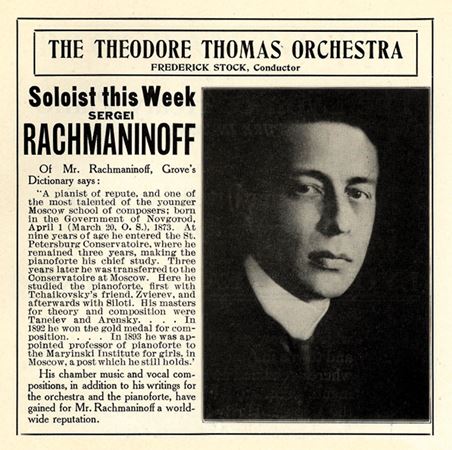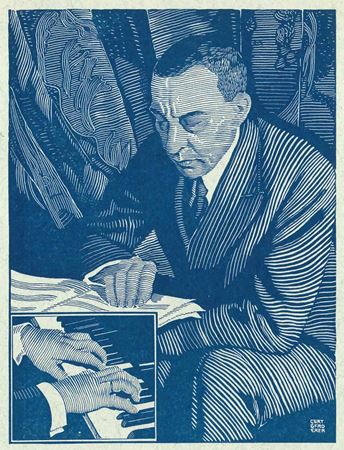Sergei Rachmaninov in 1921
Kubey Rembrandt Studios, Philadelphia (Library of Congress)
In late 1941, second music director Frederick Stock led the Chicago Symphony Orchestra in an all-Rachmaninov concert on November 7 and 8, featuring the Vocalise, Third Symphony, Isle of the Dead and Fourth Piano Concerto with the composer as soloist. A month later on December 11 and 12, Stock conducted the Orchestra’s first performances of Rachmaninov’s final major composition, his Symphonic Dances. These concerts would be the closing bookends to Stock and Sergei Rachmaninov’s working relationship.
Their collaboration began on December 3 and 4, 1909, when Rachmaninov made his debut in Chicago. On the first half of the program, the composer conducted his Isle of the Dead, and after intermission, he was soloist in his Second Piano Concerto under Stock’s baton.
Stock became fascinated with the work of Rachmaninov, programming the composer’s pieces more than 70 times, including more than two dozen sets of concerts featuring the Second Symphony. The Chicago Daily Tribune noted on the Rachmaninov’s first recital in Orchestra Hall on March 10, 1919, “If Sergei Rachmaninov’s audience of yesterday was, more than anything else, a tribute to the composer of the C-sharp minor prelude, then that familiar fragment is one of the most valuable and vital of all piano-pieces: no other pianist in at least three years has drawn such a crowd in Chicago. . . . Of course, knowledge of and remembrance for Rachmaninov’s in his other and more important aspects had something to do with yesterday’s outpour: his Second Symphony is virile and popular matter in the Orchestra’s ready repertoire.”
When the first phonograph recording of the Second Symphony was produced in 1934— by RCA Victor with the Minneapolis Symphony Orchestra under its music director Eugene Ormandy — Edward Moore of the Chicago Tribune quoted Stock on November 11, 1934, stating, “Where will we find another to write another Second Symphony.” Also in the Tribune, shortly after Rachmaninov’s passing, Cecil Smith mentioned on April 25, 1943, “I remember going backstage one time after Mr. Stock had conducted Rachmaninov’s Second Symphony, to find him still caught up in the personal exhilaration of the score invariably brought him, murmuring, ‘It’s a very beautiful work.’”
In concert together, Stock and Rachmaninov’s connection was palpable. On October 22, 1940, during the Orchestra’s 50th season, the composer was soloist in Beethoven’s First Piano Concerto and his Rhapsody on a Theme of Paganini. Edward Barry from the Tribune was on hand. “So persuasive was the festal mood of this concert that Mr. Stock actually grinned and even Mr. Rachmaninov almost smiled.”












Soon after Stock passed away from a sudden heart attack on October 20, 1942, and Rachmaninov sent his condolences to the Stock family. A few months later, the composer performed for the last time with the Orchestra on February 11 and 12, 1943. Again, he performed Beethoven’s First Piano Concerto and his Rhapsody on a Theme of Paganini under the baton of Hans Lange, the associate conductor. A little more than a month later, Rachmaninov died on March 28, 1943, in Beverly Hills, California.
In the Tribune, Cecil Smith wrote on April 25, 1943, “It is perhaps inevitable that we should be unable to dissociate the names of Rachmaninov and Stock. Despite their different national backgrounds and points of origin, the two men seemed to share essentially the same musical horizon, and even their assumptions about what was good and proper and expressive rested upon a common agreement about the validity of rich, highly colored, deeply emotionalized music in the late Romantic period”.
Following the Orchestra’s first performances of the Symphonic Dances in 1941, Edward Barry in the Chicago Tribune stated, “This reporter, always on the prowl for news, found last night’s Chicago Symphony Orchestra concert a singularly uneventful one.” But the Rachmaninov’s last major composition would soon undergo a reevaluation. When the piece reappeared for only the fourth time in Orchestra Hall in December 1988, John von Rhein, also writing for the Tribune, commented, “This heady performance served as a reminder that the critical consensus has once again shifted in Rachmaninov’s favor. The pompous savants who once found so much to deplore in the ’gushing’ music are finally admitting what the public knew all along — that Rachmaninov, the last Romantic, was a good composer and his music is here to stay.”
The composer’s Symphonic Dances were most recently performed in Orchestra Hall in February 2023, and Phillip Huscher, scholar-in-residence and program annotator, wrote, “Rachmaninov died believing that [his last score] would never find the kind of popularity his earlier music so easily won. . . . But in recent years, the score has become a favorite of orchestras and audiences alike — Rachmaninov’s star is once again on the rise.”



